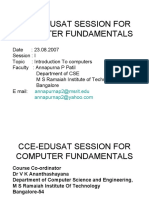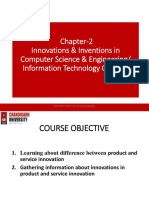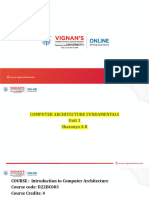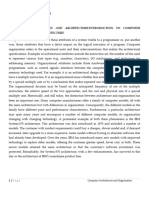Introduction To Computers & Programming in C: MR - Vivek Parashar Assistant Professor (ASET)
Uploaded by
vivekparasharIntroduction To Computers & Programming in C: MR - Vivek Parashar Assistant Professor (ASET)
Uploaded by
vivekparasharAmity School of Engineering & Technology
Introduction to Computers &
Programming in C
(BTC\BTI\BTE\BTM\BTB-105)
by
Mr.Vivek Parashar
Assistant Professor (ASET)
( Email : vparashar@gwa.amity.edu)
1
Amity School of Engineering & Technology
About Myself
I am Vivek Parashar Assistant Professor (ASET) AmityUniversity,Gwalior.
Amity is ranked as number one Private University in India in survey of various Media houses.
Amity is having around 80000 Students. Amity is having more than 1500 Acre of campuses. Nearly 100% placement in all courses
B.Tech (2002) and M.Tech (2006) from NIT Raipur
Having more than 6 years of teaching experience I am also a corporate trainer of Wipro Technologies.
2
Amity School of Engineering & Technology
Unit 1:Introduction to Computer and Number
Course Content
System : 4 Hour
Unit 2: Programming in C and its basics : 6 Hour Unit 3: Fundamental Features in C ( loops , switch, break, storage type & Preprocessor) : 9 Hour Unit 4: Arrays and Functions with recursion: 7 Hour
Unit 5: Advanced features in (Pointers,string ,Structures & file handling): 7 Hour
3
Amity School of Engineering & Technology
Text & References
ANSI C by E Balagurusamy ,TMH Publication,4th Edition,2009 Yashwant Kanetkar, Let us C, BPB Publications, 2nd Edition, 2001. Herbert Schildt, C: The complete reference, Osbourne Mcgraw Hill, 4th Edition, 2002. V. Raja Raman, Computer Programming in C, Prentice Hall of India, 1995.
4
Amity School of Engineering & Technology
References
Kernighan & Ritchie, C Programming Language, The (Ansi C Version), PHI, 2nd Edition. J. B Dixit, Fundamentals of Computers and Programming in C, Laxmi Publication 2nd Edition. P.K. Sinha and Priti Sinha, Computer Fundamentals, BPB publication, 4th Edition,2003.
5
Amity School of Engineering & Technology
Grading Guidelines
S. No Evaluation Component
1. 2. 3. 3. 4. Home Assignment Quiz Class Test Attendance End-Semester Examination Total
Weight (%)
5 5 15 5 70 100
6
Amity School of Engineering & Technology
Course Objective
To acquire the basic knowledge of computer system and its parts(H/W & S/W) To familiarize with various important features of procedure oriented programming language i.e. C
Amity School of Engineering & Technology
Learning Outcome
By the end of this course, students will be able to: Identify & define various types of Computer systems and there parts. Describe the working principal of computer and the data used by computer system and various number systems. Understand the Procedural programming methodology its pros and concerns . Understand how to programme efficiently .
8
Amity School of Engineering & Technology
My Promise to you
I will treat you with respect I will be available for questions (after class, during office hours) I will arrive prepared to teach I will try to be engaging and helpful I will grade you fairly and objectively
Amity School of Engineering & Technology
University Expectations
Come to class on-time (especially during exams) Turn in work on-time Do all work independently (except group work) Follow Rules of Conduct and Academic Behavior Standards as detailed in the Student Regulations. Take responsibility for your own learning!
10
Amity School of Engineering & Technology
My Expectations
Treat each other with respect Work hard Ask if you have questions!
11
Amity School of Engineering & Technology
Unit 1
12
Amity School of Engineering & Technology
Discussion Questions
What defines a computer:
What is the simplest definition of a computer you can come up with?
What was the first computer?
If you dont know, make a guess
13
Amity School of Engineering & Technology
What Is A Computer?
A computer is an electronic device, operating under the control of instructions (software) stored in its own memory unit, that can accept data (input), manipulate data (process), and produce information (output) from the processing. Generally, the term is used to describe a collection of devices that function together as a system.
14
Amity School of Engineering & Technology
What was the first computer?
The first computers were people! "Computer" was originally a job title: it was used to describe those human beings (predominantly women) whose job was to perform the repetitive calculations required to compute such things as navigational tables, tide charts, and planetary positions for astronomical purpose.
15
Amity School of Engineering & Technology
History of Computers
Computer" was originally a job title: it was used to describe those human beings (predominantly women) whose job it was to perform the repetitive calculations required to compute such things as navigational tables, tide charts, and planetary positions for astronomical use.
16
Amity School of Engineering & Technology
A typical computer operation back when computers were people
17
Amity School of Engineering & Technology
Abacus
The abacus was an early aid for mathematical computations which was used in 300 B.C. by the Babylonians A modern abacus consists of rings that slide over rods
18
Amity School of Engineering & Technology
Old & New Abacus
19
Amity School of Engineering & Technology
Napier's Bones
In 1617 an eccentric (some say mad) Scotsman named John Napier invented logarithms, which are a technology that allows multiplication to be performed via addition. The logarithm values were carved on ivory sticks which are now called Napier's Bones.
20
Amity School of Engineering & Technology
An original set of Napier's Bones [photo courtesy IBM]
A more modern set of Napier's Bones
21
Amity School of Engineering & Technology
Slide Rule
The slide rule,(based on Napier fundamental) first built in England in 1632 and still in use in the 1960's by the NASA engineers of the Mercury, Gemini, and Apollo programs which landed men on the moon.
22
Amity School of Engineering & Technology
Gear Driven Calculator
Leonardo da Vinci (1452-1519) made drawings of gear-driven calculating machines but apparently never built any.
23
Amity School of Engineering & Technology
Schickard Calculating Clock
The German professor Wilhelm Schickard in 1623 designed first gear-driven calculating machine Known as Schickard calculating clock
24
Amity School of Engineering & Technology
Pascal's Pascaline
In 1642 Blaise Pascal, at age 19, invented the Pascaline as an aid for his father who was a tax collector. Pascal built 50 of this gear-driven one-function calculator
25
Amity School of Engineering & Technology
Pascal's Pascaline [photo 2002 IEEE]
26
Amity School of Engineering & Technology
A 6-digit model for those who couldn't afford the 8 digit model
27
Amity School of Engineering & Technology
Stepped Reckoner
After a few years after Pascal, the German Gottfried Wilhelm Leibniz (co-inventor with Newton of calculus) managed to build a four-function (addition, subtraction, multiplication, and division) calculator that he called the stepped reckoner
28
Amity School of Engineering & Technology
Punched Cards
In 1801 the Frenchman Joseph Marie Jacquard invented a power loom that could base its weave (and hence the design on the fabric) upon a pattern automatically read from punched wooden cards, held together in a long row by rope. Descendents of these punched cards have been in use ever since
29
Amity School of Engineering & Technology
Jacquard's Loom showing the threads and the punched cards
30
Amity School of Engineering & Technology
Difference Engine
By 1822 the English mathematician Charles Babbage was proposing a steam driven calculating machine the size of a room, which he called the Difference Engine
In 1833 he designed Analytic Engine could store numbers ,calculating mill used punched metal cards for instructions,powered by steam,accurate to six decimal places.
31
Amity School of Engineering & Technology
A small section of the type of mechanism employed in Babbage's Difference Engine [photo 2002 IEEE]
32
Amity School of Engineering & Technology
Mark I
The first computer Mark I built by Harvard and IBM in 1944. This was the first programmable digital computer made in U.S. It was not a purely electronic computer. As it was constructed out of switches, relays, rotating shafts, and clutches. The machine weighed 5 tons, incorporated 500 miles of wire, was 8 feet tall and 51 feet long, and had a 50 ft rotating shaft running its length, turned by a 5 horsepower electric motor.
33
Amity School of Engineering & Technology
The Harvard Mark I: an electro-mechanical computer
34
Amity School of Engineering & Technology
First Computer Bug
Grace Hopper a programmer found the first computer "bug": a dead moth that had gotten into the Mark I and whose wings were blocking the reading of the holes in the paper tape, she is credited for coining the word "debugging" to describe the work to eliminate program faults. Mark I and whose wings were blocking the reading of the holes in the paper tape
35
Amity School of Engineering & Technology
The First Computer Bug [photo 2002 IEEE]
36
Amity School of Engineering & Technology
Generations of Computer
History of computer is divided in to five generations Each generation is characterized by major technological development Fundamental changes in terms of o Size o Cost o Power o Efficiency o Reliability
37
Amity School of Engineering & Technology
First Generation(Vacuum Tube1941-1956)
First Generation Electronic Computers used Vacuum Tubes Vacuum tubes are glass tubes with circuits inside. Vacuum tubes have no air inside of them, which protects the circuitry.
38
Amity School of Engineering & Technology
ENIAC - 1946
Electronic numerical integrator & computing first fully electronic digital computer built in the U.S. Created at the University Of Pennsylvania by J. Presper Eckert (1919 - 1995) and John W. &Mauchly (1907 - 1980) ENIAC weighed 30 tons contained 18,000 vacuum tubes Cost a paltry $487,000
39
Amity School of Engineering & Technology
ENIAC-1946
40
Amity School of Engineering & Technology
First Commercial Computer
1947 - Eckert-Mauchly Computer Corporation UNIVAC I (Universal Automatic Computer) US Bureau of Census 1950 calculations Became part of Sperry-Rand Corporation Late 1950s - UNIVAC II
Faster More memory
41
Amity School of Engineering & Technology
IBM
Punched-card processing equipment 1953 - the 701
IBMs first stored program computer Scientific calculations
1955 - the 702
Business applications
Lead to 700/7000 series
42
Amity School of Engineering & Technology
Second Generation 1955-1964
Transistors were used in the circuits. The input operations were performed using punched cards and magnetic tapes and for output operations, punched cards and papers were used. For external storage magnetic tapes were used. The orientation was towards multiple users i.e. the machine was capable to process multiple tasks concurrently.
43
Amity School of Engineering & Technology
The high level languages like FORTRAN, COBOL, BASIC etc. were used as the languages by the computer. Example of Computers: IBM 1400 and 7000 series, General Electric 635 , PDP 1, NCR & RCA produced small transistor machines.
44
Amity School of Engineering & Technology
First Transistor
Uses Silicon In 1948 John Bardeen, Walter Brattain & William -Shockley discovered the "transfer resistor"; later labeled the transistor. won a Nobel prize
45
Amity School of Engineering & Technology
Third Generation
1965-1974
Integrated circuits replaced transistors. Inspite of their smaller size they were capable to perform better than transistors. For data input and output operations monitors and keyboards replaced the punched cards. For external storage magnetic disks were used. Sophisticated operating systems, which were capable of handling several jobs concurrently were used.
46
Amity School of Engineering & Technology
More advanced high level languages like PASCAL were used. Example of computers:1971 - 4004 First microprocessor All CPU components on a single chip 4 bit
Followed in 1972 by 8008
8 bit Both designed for specific applications
1974 - 8080
Intels first general purpose microprocessor
47
Amity School of Engineering & Technology
Integrated Circuits
Third Generation Computers used Integrated Circuits (chips). Integrated Circuits are transistors, resistors, and capacitors integrated together into a single chip 48
Amity School of Engineering & Technology
Fourth Generation 1975-1989
The circuits used VLSI and microprocessors of virtually microscopic size, which led to drastic cut on the size of computer. The input output devices were the same monitors, keyboard, printer etc. Micro computers have evolved. Magnetic disks were the primary devices used for external storage.
49
Amity School of Engineering & Technology
The use of special software for maintaining large data bases became popular. The application software for micro computer essentially became popular in this generation. Example of computers:1975, 801 minicomputer project (IBM) RISC Berkeley RISC I processor 1986, IBM commercial RISC workstation product, RT PC.
50
Amity School of Engineering & Technology
Fifth Generation 1990-present
The computers of this generation use optic fibre technology to handle Artificial Intelligence. These computers have capacity to think and reason which can be used to solve problems where human intelligence is required. Expert Systems are examples of systems implementing Artificial Intelligence (AI).
51
Amity School of Engineering & Technology
Looking in Future
Grid Computing Nano Technology Quantum Computing DNA Computing Cloud Computing
52
Amity School of Engineering & Technology
Computer History Timeline
Year
1936
Inventors/inventions
Conrad Zuse Z1 Computer
Description of events
First Programmable Computer
1944
H.Aiken & G.Hopper Harvard Mark 1 Computer 1946 J.P.Eckert & J.W.Mauchly ENIAC 1 1947/48 J.Barden,W.Brattain & W. Shokley The Transister
Harvard Architecture
18000 Vacuum tubes This invention greatly Effected the history of computer
53
Amity School of Engineering & Technology
Cont
Year
1951
Inventors/inventions
John Presper Eckert & John W. Mauchly UNIVAC Computer
Description of events
First commercial computer & able to pick presidential winners
1953
1954
International Business Machines IBM 701 EDPM Computer
John Backus & IBM FORTRAN Computer Programming Language The first successful high level programming language.
IBM enters into 'The History of Computers
The first successful high level programming language. The first bank industry computer - also MICR (magnetic ink character recognition) for reading checks
1955 in use 1959
54
Amity School of Engineering & Technology
Cont.
Year
1958 1962 1964
Inventors/inventions
Jack Kilby & Robert Noyce The Integrated Circuit Steve Russell & MIT Spacewar Computer Game Douglas Engelbart Computer Mouse & Windows ARPAnet Intel 1103 Computer Memory
Description of events
Otherwise known as 'The Chip' The first computer game invented. Nicknamed the mouse because the tail came out the end. The original Internet. The world's first available dynamic RAM chip.
55
1969 1970
Amity School of Engineering & Technology
Cont..
Year
1971
Inventors/inventions
Faggin, Hoff & Mazor Intel 4004 Computer Microprocessor
Description of events
The first microprocessor.
1971
1973 1974/75 1976/77
Alan Shugart &IBM The "Floppy" Disk
Robert Metcalfe & Xerox The Ethernet Computer Networking Scelbi & Mark-8 Altair & IBM 5100 Computers Apple I, II & TRS-80 & Commodore Pet Computers
Nicknamed the "Floppy" for its flexibility.
Networking. The first consumer computers. More first consumer computers.
56
Amity School of Engineering & Technology
Cont.
Year
1978
Inventors/inventions
Dan Bricklin & Bob Frankston VisiCalc Spreadsheet Software Seymour Rubenstein & Rob Barnaby WordStar Software IBM The IBM PC - Home Computer Microsoft MS-DOS Computer Operating System
Description of events
Any product that pays for itself in two weeks is a surefire winner. Word Processors.
1979
1981
From an "Acorn" grows a personal computer revolution From "Quick And Dirty" comes the operating system of the century.
57
1981
Amity School of Engineering & Technology
Cont..
Year
1983
Inventors/invent Description of ions events
Apple Lisa Computer The first home computer with a GUI, graphical user interface. The more affordable home computer with a GUI. Microsoft begins the friendly war with Apple. CONTINUED
1984
Apple Macintosh Computer Microsoft Windows TO BE
1985 SERIES
58
Amity School of Engineering & Technology
First Hard Disk
IBM 305 RAMAC First moving head hard disk drive 20 MB in size Rent is 3200 $ P/M Weight 5 Tones
59
Amity School of Engineering & Technology
THANK YOU
60
You might also like
- Cce-Edusat Session For Computer FundamentalsNo ratings yetCce-Edusat Session For Computer Fundamentals33 pages
- Cce-Edusat Session For Computer FundamentalsNo ratings yetCce-Edusat Session For Computer Fundamentals33 pages
- COS101 Introduction To Computing SciencesNo ratings yetCOS101 Introduction To Computing Sciences65 pages
- CSE 2001 Computer Architecture & Organization: Prof. Krishnamoorthy A School of Computer Science and EngineeringNo ratings yetCSE 2001 Computer Architecture & Organization: Prof. Krishnamoorthy A School of Computer Science and Engineering16 pages
- Lecture 1 en Object of Study History 2014No ratings yetLecture 1 en Object of Study History 201463 pages
- CSC111 - Introduction To Computer Sciences - Part1No ratings yetCSC111 - Introduction To Computer Sciences - Part132 pages
- Cce-Edusat Session For Computer FundamentalsNo ratings yetCce-Edusat Session For Computer Fundamentals33 pages
- CSC 111 Introduction To Computer Systems 20182019No ratings yetCSC 111 Introduction To Computer Systems 2018201937 pages
- Chapter-2 Innovations & Inventions in Computer Science & Engineering/ Information Technology CST-156No ratings yetChapter-2 Innovations & Inventions in Computer Science & Engineering/ Information Technology CST-15633 pages
- Introduction To Computer: by Kiramat Rahman Department of Computer & Software TechnologyNo ratings yetIntroduction To Computer: by Kiramat Rahman Department of Computer & Software Technology48 pages
- Application of Information and Computing Technologies Lecture 2No ratings yetApplication of Information and Computing Technologies Lecture 250 pages
- Week1-Fundamental of Computer Science-Uploaded 1No ratings yetWeek1-Fundamental of Computer Science-Uploaded 142 pages
- Computer Intro, Characteristics, HistoryNo ratings yetComputer Intro, Characteristics, History6 pages
- Introduction To Computer Architecture Unit 1 Live SessionNo ratings yetIntroduction To Computer Architecture Unit 1 Live Session28 pages
- Lecture 1-Microcomputer Application (INSY 116)No ratings yetLecture 1-Microcomputer Application (INSY 116)57 pages
- Lesson 2 History of Basic Computing PeriodsNo ratings yetLesson 2 History of Basic Computing Periods6 pages
- Unit 1 Introdution To Computers and LogicNo ratings yetUnit 1 Introdution To Computers and Logic45 pages
- Hsslive Xi Computer Science English All in One Notes by Act MalappuramNo ratings yetHsslive Xi Computer Science English All in One Notes by Act Malappuram66 pages
- Unit 1 History of Information Technology: StructureNo ratings yetUnit 1 History of Information Technology: Structure25 pages
- PHD Course Work: Computer Applications-IiaNo ratings yetPHD Course Work: Computer Applications-Iia41 pages
- 1-Chapter 1-Introduction To EngineeringNo ratings yet1-Chapter 1-Introduction To Engineering52 pages
- Learning Objectives: in This Chapter You Will Learn AboutNo ratings yetLearning Objectives: in This Chapter You Will Learn About50 pages
- Learning Objectives: in This Chapter You Will Learn AboutNo ratings yetLearning Objectives: in This Chapter You Will Learn About29 pages
- Deadlock: Amity School of Engineering & TechnologyNo ratings yetDeadlock: Amity School of Engineering & Technology40 pages
- This Page Lists C Operators in Order of PrecedenceNo ratings yetThis Page Lists C Operators in Order of Precedence2 pages
- FPGA Implementation of Biometric Based Elevator Controller: March 2018No ratings yetFPGA Implementation of Biometric Based Elevator Controller: March 201810 pages
- Computer Architecture: Lecture: 9 - 13 Types of Memories Cache, Internal and ExternalNo ratings yetComputer Architecture: Lecture: 9 - 13 Types of Memories Cache, Internal and External69 pages
- Integration Services - Extending Packages With ScriptingNo ratings yetIntegration Services - Extending Packages With Scripting188 pages
- Barracuda NextGen Firewall F WAN Track-Student Guide Rev1No ratings yetBarracuda NextGen Firewall F WAN Track-Student Guide Rev192 pages
- Kendriya Vidyalaya Sangathan Model Question Paper - 2 Class-XII Subject: Computer Science (083) Time 3 Hrs MM 70No ratings yetKendriya Vidyalaya Sangathan Model Question Paper - 2 Class-XII Subject: Computer Science (083) Time 3 Hrs MM 7024 pages
- Exercices - Certification Oracle 1Z0-803No ratings yetExercices - Certification Oracle 1Z0-803147 pages
- Value Help in Adobe Interactive Forms: Installation (ZCI)No ratings yetValue Help in Adobe Interactive Forms: Installation (ZCI)6 pages
- Familiarization With PC Components: Computer Hardware and Networking Lab (R707)No ratings yetFamiliarization With PC Components: Computer Hardware and Networking Lab (R707)93 pages
- Converting SMART FORMS Output To PDF FormatNo ratings yetConverting SMART FORMS Output To PDF Format4 pages
- User's Manual: Hi-Speed USB 2.0 Flash DiskNo ratings yetUser's Manual: Hi-Speed USB 2.0 Flash Disk15 pages
- CSE 2001 Computer Architecture & Organization: Prof. Krishnamoorthy A School of Computer Science and EngineeringCSE 2001 Computer Architecture & Organization: Prof. Krishnamoorthy A School of Computer Science and Engineering
- CSC111 - Introduction To Computer Sciences - Part1CSC111 - Introduction To Computer Sciences - Part1
- Chapter-2 Innovations & Inventions in Computer Science & Engineering/ Information Technology CST-156Chapter-2 Innovations & Inventions in Computer Science & Engineering/ Information Technology CST-156
- Introduction To Computer: by Kiramat Rahman Department of Computer & Software TechnologyIntroduction To Computer: by Kiramat Rahman Department of Computer & Software Technology
- Application of Information and Computing Technologies Lecture 2Application of Information and Computing Technologies Lecture 2
- Introduction To Computer Architecture Unit 1 Live SessionIntroduction To Computer Architecture Unit 1 Live Session
- Hsslive Xi Computer Science English All in One Notes by Act MalappuramHsslive Xi Computer Science English All in One Notes by Act Malappuram
- Unit 1 History of Information Technology: StructureUnit 1 History of Information Technology: Structure
- Learning Objectives: in This Chapter You Will Learn AboutLearning Objectives: in This Chapter You Will Learn About
- Learning Objectives: in This Chapter You Will Learn AboutLearning Objectives: in This Chapter You Will Learn About
- Deadlock: Amity School of Engineering & TechnologyDeadlock: Amity School of Engineering & Technology
- This Page Lists C Operators in Order of PrecedenceThis Page Lists C Operators in Order of Precedence
- FPGA Implementation of Biometric Based Elevator Controller: March 2018FPGA Implementation of Biometric Based Elevator Controller: March 2018
- Computer Architecture: Lecture: 9 - 13 Types of Memories Cache, Internal and ExternalComputer Architecture: Lecture: 9 - 13 Types of Memories Cache, Internal and External
- Integration Services - Extending Packages With ScriptingIntegration Services - Extending Packages With Scripting
- Barracuda NextGen Firewall F WAN Track-Student Guide Rev1Barracuda NextGen Firewall F WAN Track-Student Guide Rev1
- Kendriya Vidyalaya Sangathan Model Question Paper - 2 Class-XII Subject: Computer Science (083) Time 3 Hrs MM 70Kendriya Vidyalaya Sangathan Model Question Paper - 2 Class-XII Subject: Computer Science (083) Time 3 Hrs MM 70
- Value Help in Adobe Interactive Forms: Installation (ZCI)Value Help in Adobe Interactive Forms: Installation (ZCI)
- Familiarization With PC Components: Computer Hardware and Networking Lab (R707)Familiarization With PC Components: Computer Hardware and Networking Lab (R707)





































































































